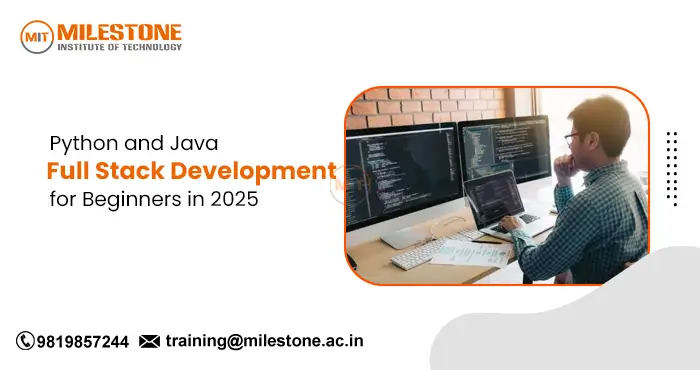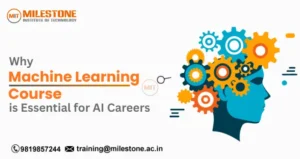
Introduction
Full stack development is rapidly becoming one of the most sought after skills among industry experts and professionals, and as we enter into 2025, the demand for full stack developers is also growing.
This area creates versatility in individuals as it lets them work on both front-end and back-end applications. Full stack development for beginners is a great way to building greater career opportunities. Because of the different programming languages, Python and Java are the best options for you to learn the whole stack. While both are strong on their own, when combined, they lay an effective foundation for anybody that wants to get started with full stack development.
Understanding Full Stack Development
Full stack development means to do development in client side and in server side. Front-end development focus on the application user interface and user experience through technologies such as HTML, CSS and JavaScript. This is the part that users touch, from button clicks to filling out forms.
Developers build the logic, database operations, and server management (in the back-end) that power the functionality behind the scenes. A full stack developer can connect the dot between both layers of these two layers, therefore helping in the development of a complete, user-friendly web application from start to finish. Full stack development has become the essential skill for the present day software industry with rapid change in complexity of web and mobile applications.
Why Choose Python for Full Stack Development?
Python has emerged as one of the most popular languages among beginners because of its simplicity and clear syntax.
Syntax is simple and straightforward, suitable to beginners who foray into the world of coding and when it comes to full stack development, Python language has solid frameworks like Django and Flask which accelerate the creation of sound and secure web applications.
These frameworks include tools and abilities that you’ll use out of the box, for basic web tasks such as authenticating users, interacting with a database, and routing URLs, in order to save your time.
Python’s large community and its rich library ecosystem also makes it easier for those new to programming to find help and solutions and its applicability to data science, automation and Machine learning makes it an even more valuable addition for those on the full stack road.
Why Learn Java for Full Stack Development?
Java has been the foundation of enterprise development for years. It is stable, scalable, and platform independent hence perfect for enterprise level applications. When it comes to full stack development, Java is a must have for the Back-end, Spring and Spring Boot have made it easy to develop reliable REST APIs and web services.
Java’s object-oriented model lets beginners grasp essential concepts easily that are also helpful when moving on to different languages. In addition, the strong typing of Java and rigid syntax checking is also able to guide novice developers from making common coding mistakes, inculcating a discipline for code that is clean and maintainable. Those who plan to develop apps for enterprises or are someone who wish to work in bank, insurance, or e-commerce industry, they should make Java as part of their full stack developer’s toolkit.
Combining Python and Java for Career Advantage
Many developers will specialize in a particular language, but making the investment in learning Python and Java will go a long way in the full stack development industry. Python is very suited for fast development and for building prototypes and light applications, even though Java is the choice, when it comes to performance-critical and enterprise-grade systems.
With both of these, beginners are ready to take on a multitude of projects, from landing pages to enterprise solutions, also being fluent in either language demonstrates to a job that you are versatile and deep enough to work with multiple teams and technologies. This versatility is in high demand in full stack development, where projects often require connecting the dots between several systems and tools.
Key Components of Full Stack Development
Being a good full-stack developer means being knowledgeable of the front-end as well as back-end components. On the front-end side, HTML organizes content on the web, CSS designs and provides a structure, while JavaScript provides interactivity and dynamicity. Well-known JavaScript libraries such as React, Angular or Vue.js add to the front-end experience with reusable components, and managing data the best possible way.
On the server, Python and Java come with the tools to handle user requests, connect with databases and return responses. When doing full stack development, you’ll be interacting with databases, like MySQL, PostgreSQL, or MongoDB, to store and manipulate your app data. Developers also need to understand how to use RESTful APIs to link front-end to back-end efficiently. With this overview, you’ll be able to develop whole applications ready for use.
Learning Path for Beginners
Full stack development learning path for beginners 2025 starts with basics of Python and Java Basic programming, data structures, loops, functions, and object oriented concepts should all be learned. Now that you are familiar with the core concepts, if you are an aspiring developer, you should learn to code small web apps using Flask or Django for Python and Spring Boot for Java.
In order to process user interaction and know how things work on the back-end, learning front-end technologies with these back-end frameworks is a must. Then as you progress to larger projects, these can be hybrid, combining both languages (for example, a Java-based back-end API interfacing to a Python machine learning module). Implementing theory, building real-time projects, and taking part in open-source code are some of the best ways to hone full stack development skills while creating an impressive portfolio for the employers.
Tools and Platforms for Modern Development
When it comes to full stack development, the tools matters a lot, it can improve the productivity and of course the code quality. Novices must know Git for versioning and GitHub for sharing code. There are various IDEs, including PyCharm for Python, IntelliJ IDEA for Java and Visual Studio code for both; here you can avail smart coding assistance, debugging, and project management tools.
Developers also have to wrap their heads around deploying their applications to cloud platforms like AWS, Heroku or the Google cloud. These services really make your apps available on line and get real world experience in how to host them in reality. Knowing how to use Docker and containerization tools is also important in full stack development to make application deployment and setting up environments easier.
Career Opportunities and Future Trends
The trend for full stack development will be increasing dynamically till 2025, powered by the digital transformation of all lines of business. Businesses are looking for developers that can take care of an entire project by themselves so that they do not need to have a separate front end and back end team hired. With both Python and Java up their sleeves, the newbies equip themselves for full stack developer, web developer, software engineer, app developer roles.
With some experience, there are also niches to discover, such as the DevOps path, cloud architecture and software architecture. We can expect full stack development in the future to become further integrated with AI, real-time, and server-less architectures. Keeping up with the latest trends and constant learning will be key to success in an industry that continues to change and develop.
Conclusion
Full stack development makes for an awesome career option for beginners in 2025. You learn both Python and Java, and you learn how to program in general and how to make full web applications all the way through. These two languages are mainstream, prevalent and commonly adopted by companies worldwide. Through learning full stack development, you can code both the front and back end of websites and apps so you become more skilled and adaptable. That’s more job opportunities and better career prospects.
If you keep learning, practicing on a daily basis and start building real projects, you will become confident and ready for work anything it real-world. Coding with full stack Python and Java is a smart and future-proof way for anyone who wants to begin a career in tech.



